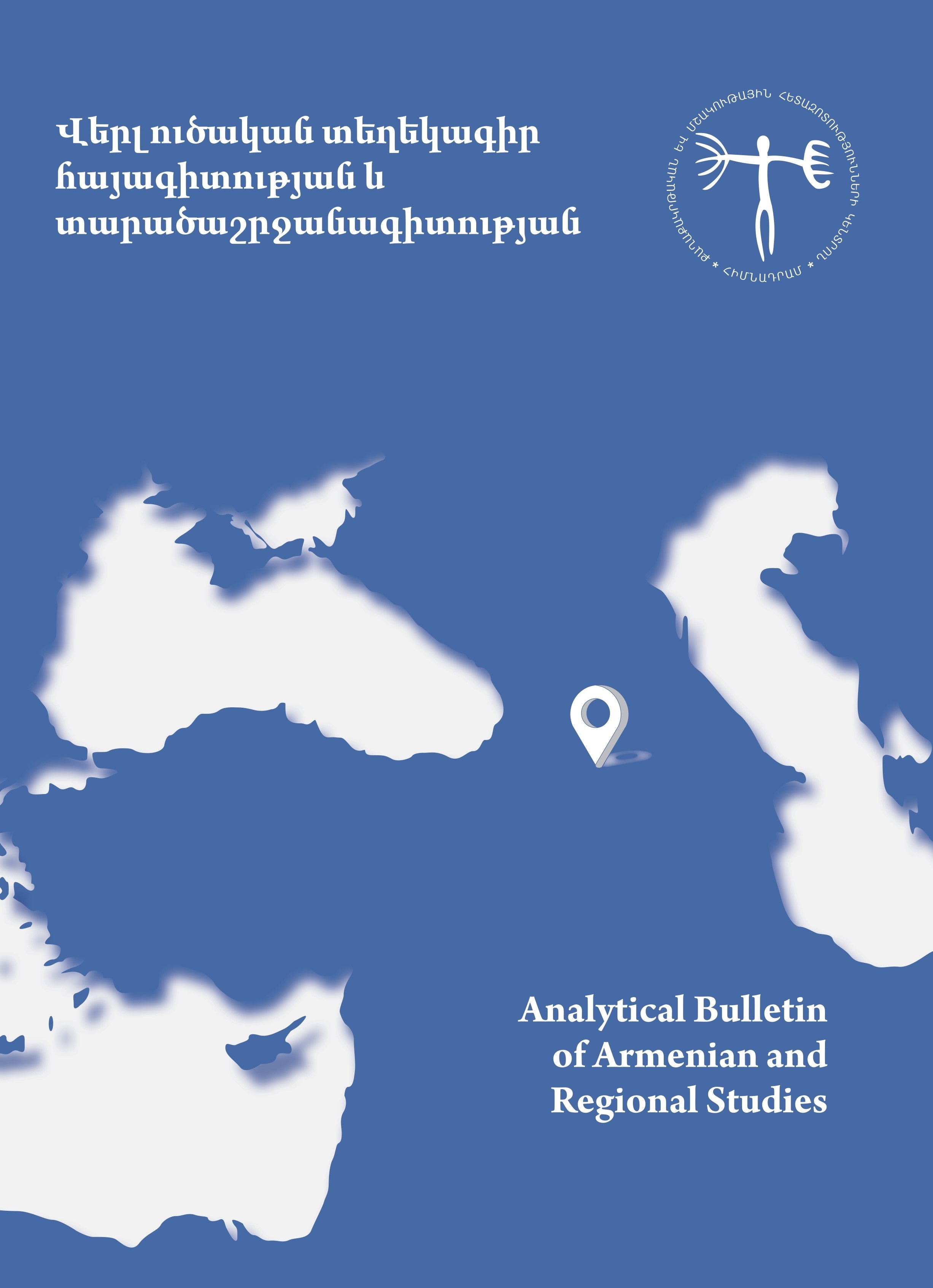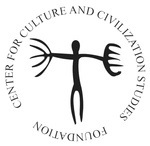ARMENIAN COMMUNITIES IN THE MIDDLE EAST: BETWEEN IMPOSED REALITIES AND UNCERTAIN FUTURE
Keywords:
Մերձավոր Արևելք, հայկական սփյուռք,, հայ եկեղեցի, փոքրամասնություններ, ինքնություն, կրոն, ռազմական հակամարտություններAbstract
This article discusses the contemporary internal and external critical issues facing the Armenian communities in the Middle East. With population estimates at about 300,000 spread in some 10 countries in the region, the Armenians are a minority within the wide spectrum of confessional, religious and ethnic non-Muslim communities in these countries. Internally, questions of integration, assimilation, preservation and maintenance of community institutions are among the most hotly debated issues. Externally, the security situation and ongoing armed conflicts, as well as the escalation of religious fundamentalism in recent years pose serious questions about the future viability of the Armenian communities in the Middle East. These processes are exacerbated by declining socio-economic conditions which have caused mass migration of Christians in general and the Armenians in particular. Over the last 100 years since the Armenian Genocide and dispersion throughout the Middle East, the Armenians have invested the equivalent of billions of dollars in money, labour and community efforts to establish and perpetuate their culture, language, and traditions. However, the continuing exodus of the Armenians out of the Middle East seems to speed up the socio-cultural demise of one of the most ancient Christian communities in the region.
References
Լևանտում 12-րդ և 13-րդ դարերում հայերի ներկայության մասին, տե´ս Mutafian C., “Les princesses arméniennes et le Liban latin” in Aida Boudjikanian (ed) Armenians of Lebanon. Beirut: Haigazian University and Armenian Heritage Press, 2009, pp. 3-20. մեր ժամանակների պատմական տեսանկյան համար, տե´ս ՝ Sanjian A.,“The Armenian Minority Experience in the Modern Arab World,” Bulletin of the Royal Institute for Inter-Faith Studies (Amman, Jordan), 3, 1 (Spring/Summer), 2001.
Մուրադյան Ս., Իրաքի Հայ Համայնքը, Երևան, Պայքար, 1997:
Zohry A., “Armenians in Egypt”, International Union for the Scientific Study of Populations, XXF IUSSP International Population Conference. Tours, France, 18-23 July 2005. http://iussp2005.princeton.edu/abstractViewer.aspx? submissionId=50135 (27 Սեպտեմբերի 2011).
Kaiser H., “The Armenians in Lebanon during the Armenian Genocide” in Aida Boudjikanian (ed) Armenians of Lebanon. Beirut: Haigazian University and Armenian Heritage Press, 2009, p. 35 5 հմմտ. Sanjian A. K., The Armenian Communities in Syria under Ottoman Dominion. Cambridge: Harvard University Press, 1965, pp. 53-56
Մինչև Առաջին համաշխարհային պատերազմը հայերի թիվը Սիրիայում և Լիբանանում կազմում էր մոտ 17-18 հազար: Սակայն համայնքները խստիվ մեծացան Առաջին համաշխարհային պատերազմի ընթացքում ցեղասպանությունից փրկվածների բազմաթիվ խմբերի ներգաղթից հետո: 1925-ին Խորհրդային Հայաստանում տպագրված թվերի համաձայն բնակչության քանակը հետևյալն է` Հալեպում և նրա շրջակայքերում` 90000, Բեյրութում `18000, Դամասկոսում` 8000, Իսկենդերունում` 8000, Լիբանանի ուրիշ մասերում` 6000, Տրիպոլիում և Զղարտայում` 5000, Բեյլիում` 6000, Պատրոսում 3000, Զահլեհում և նրան մոտակա գյուղերում` 3000, Սայդայում և Սաուրում` 3000; Յունիեհում 2500, Տաղերում` 2500 (Հայաստանի Կոչնակ, 1925: 79: մեջ է բերված Աբրահամյան Ա. Կ., Համառոտ Ուրվագիծ Հայ Գաղթավայրերի Պատմության, Հտ. 2. Երևան, Հայաստան Հրատարակչություն, 1967, էջ 22).
-ականներին Իրաքում կար 30000 հայ, Եգիպտոսում` 25000-28000, Սիրիայում` մոտ 150000 (60000` Հալեպում), և Լիբանանում` 35000-40000: Համապատասխան երկրների վերաբերյալ տվյալների համար տե´ս Հայ Սփյուռք, Հանրագիտարան (Հայկական Սփյուռքի Հանրագիտարան), Երևան, Հայկական Հանրագիտարան Հրատարակչություն, 2003:
Catholicos Aram I, “The Armenian Church in the Middle East: Some Facts and Perspectives” in Seta Dadoyan (ed.) The Contribution of the Armenian Church to the Christian Witness in the Middle East. Antelias, Lebanon: Armenian Catholicosate of Cilicia, 2001, p. 14.
Երուսաղեմի Հայոց Պատրիարքությունը բացառություն է կազմում, քանի որ պատրիարքի ընտրությունը և պատրիարքարանի գործերի կառավարումը տեղի է ունենում միայն Սրբոց Հակոբյանց միաբանության անդամների (վանականների) կողմից` առանց աշխարհիկ մարդկանց մասնակցության:
Migliorino N., (Re)constructing Armenia in Lebanon and Syria: ethno-cultural diversity and the state in the aftermath of a refugee crisis. New York, Berghahn Books, 2008, p. 71.
Տե´ս Սիրիայի և Լիբանանի վերաբերյալ համապատասխան բաժինները` Հայ Սփյուռք, Հանրագիտարան (Հայկական Սփյուռքի Հանրագիտարան), Երևան, Հայկական Հանրագիտարան Հրատարակչություն, 2003:
Հմմտ. Migliorino N., (Re)constructing Armenia in Lebanon and Syria: ethno-cultural diversity and the state in the aftermath of a refugee crisis. New York, Berghahn Books, 2008, p. 202 և Հայ Սփյուռք, Հանրագիտարան (Հայկական Սփյուռքի Հանրագիտարան), Երևան, Հայկական Հանրագիտարան Հրատարակչություն, 2003:
Հարցազրույց Կորյուն Արքեպս. Պապյանի` Իսֆահանի թեմի նախկին առաջնորդի հետ, 25 սեպտեմբերի 2008:
Catholicos Aram I, “The Armenian Church in the Middle East: Some Facts and Perspectives” in Seta Dadoyan (ed.) The Contribution of the Armenian Church to the Christian Witness in the Middle East. Antelias, Lebanon: Armenian Catholicosate of Cilicia, 2001, pp. 15-16.
“The Current Situation of the Armenians in Lebanon, Turkey, Iran and the Soviet Union,” European Parliament, Session Documents, Series A. Document A 2-33/97, Part A, B + C. Strasbourg, 15 April 1987.
Սիրիայի սահմանադրություն, Գլուխ 4-րդ, Հոդված 21-րդ (1973), մեջբերված է Migliorino N., (Re)constructing Armenia in Lebanon and Syria: ethno-cultural diversity and the state in the aftermath of a refugee crisis. New York, Berghahn Books, 2008, p. 163.
Dink H., “Kinkel ve Valilik,” Ակօս, 21 Օգոստոսի, 1998:
CNEWA“Christians in the Middle East.” Special Edition of ONE, September, New York, 2010. http://www.cnewa.org/default.aspx?ID=3483&pagetype ID=4&sitecode=HQ&pageno=2 (15 Օգոստոսի 2011).
Ertan Ö., “Foundations in search of justice”, Ակօս, 16 Նոյեմբերի, 2007:
Berberyan B., “I know that suitcase!”, Ակօս, 16 Նոյեմբերի, 2007:
Օրինակ` տե´ս Ռուբինա Արթինյանի (հայկական երգչախմբերի մասին) և Նոռա Սալմանյանի (երաժշտության մասին) հոդվածները (Boudjikanian A. (ed) Armenians of Lebanon, Beirut: Haigazian University and Armenian Heritage Press, 2009: Նույնպես, հայ նկարիչների մասին տե´ս Tchilingirian H., “Master of Grand Theater. Gerard Avedissian in the Cultural Landscape of Lebanon”, Armenian International Magazine (AIM), June, 1999, Tchilingirian H., “Looking to the East. Chant Avedissian rediscovers and redefines Egyptian visual art”, Armenian International Magazine (AIM), August-September, 1999, Tchilingirian H., “Witness of His Time. The Oppressed and the Rejected Find Dignity and Respect in Norikian”, Armenian International Magazine (AIM), March, 2000.
Tchilingirian H., “Crisis Without Borders. The Media in the Middle East”, Armenian International Magazine (AIM), July, 1999.
http://www.unesco.org/culture/languages-atlas/ (26 Սեպտեմբերի 2011): 24 Tchilingirian H., “Master of Grand Theater. Gerard Avedissian in the Cultural Landscape of Lebanon”, Armenian International Magazine (AIM), June, 1999.
հմմտ. Tchilingirian H., “Hrant Dink and Armenians in Turkey” in Turkey: Writers, Politics and Free Speech, Open Democracy Quarterly, 1, 2., 2007 http://www.opendemocracy.net/democracy-turkey/dink_armenian_4378.jsp
Barsamian D., “An Interview with Etyen Mahcupyan,” Armenian Weekly Online; 73, 28, (14 Հուլիսի 2007):
Migliorino N., (Re)constructing Armenia in Lebanon and Syria: ethno-cultural diversity and the state in the aftermath of a refugee crisis. New York, Berghahn Books, 2008, pp. 198-199.
Tchilingirian H., “Integration: The Point of No Return”, Armenian International Magazine (AIM), December, 1999.
CNEWA “Christians in the Middle East.” Special Edition of ONE, September, New York, 2010. (15 Օգոստոսի 2011). http://www.cnewa.org/default.aspx?ID=3490&pagetypeID=4&sitecode=HQ&pageno=1
Keshishian A., The Christian Witness at the Crossroads in the Middle East. Beirut: Middle East Council of Churches, 1981, p. 24.
Տե´ս, օրինակ, Steven Lee Myers, “More Christians Flee Iraq after New Violence,” The New York Times, 12 Դեկտեմբերի 2010. http://www.nytimes.com/2010/12/13/world/middleeast/13iraq.html (13 Դեկտեմբերի 2010); և “Al-Azhar Condemns Violence against Christians” http://asianews.it/newsen/Cairo.-Al-Azhar-condemns-violence-against-Christians-20996.html (10 Մարտի 2011):
“Christians Fear Islamist Pressure in Egypt,” Associated Press (AP) 4 Հոկտեմբերի 2011: http://news.yahoo.com/christians-fear-islamist-pressure-egypt-164823245.
“Christian Broadcasting in Arab Countries” in Religious Broadcasting in the Middle East. Islamic, Christian and Jewish Channels: Programmes and Discourse. Cambridge Arab Media Project (CAMP) and The Prince AlWaleed Bin Talal Centre of Islamic Studies, University of Cambridge (CIS), Ապրիլ 2010: http://www.cis.cam.ac.uk/Cambridge%20Media%20Report.pdf (18 Նոյեմբերի 2010):
Diamond L., “Why are there no Arab democracies?”, Journal of Democracy, 21, 1, January, 2010, pp. 95-96.
Stern, R. L.. ‘Perspectives: Caught in the Middle’, One (Catholic Near East Welfare Agency (CNEWA), September 2010. Տես նաև http://www.cnewa.org/default.aspx? ID=3495&pagetypeID=4&sitecode=HQ&pageno=1. Perspectives
Ըստ 1989 թ.-ի Թաիֆ Համաձայնության (Taif Accord), Լիբանանի Խորհրդարանի 128 տեղից 6-ը տրամադրվում է հայերին, որոնք կազմում են Լիբանանի բնակչության մոտ 9-ը տոկոսը:
Tchilingirian, H., “The People's Choice. Archbishop Mesrob Mutafyan Elected 84th Armenian Patriarchate of Turkey”, Armenian International Magazine (AIM), December, 1998.
Tchilingirian H., “Instilling the Armenian Spirit. Armenian Education in a Transient Community”, Armenian International Magazine (AIM), July, 1999.
CNEWA “Christians in the Middle East.” Special Edition of ONE, September, New York, 2010. http://www.cnewa.org/default.aspx?ID=201& pagetypeID=3&sitecode=HQ&pageno=1 (15 Օգոստոսի 2011).
Այս խնդիրների եռանդուն ջատագովն էր հանդիսանում Ղպտի Եկեղեցու նախկին Պապ Շենուդան (Pope Shenouda): Երբ 2011-ի հունվարին եկեղեցու տարածքում պայթած ռումբի հետևանքով 25 ղպտի զոհվեցին, նա կրկին դիմեց Եգիպտոսի կառավարությանը, ասելով որ, այն «պետք է սկսի լուծել ղպտիների խնդիրները», որոնք ընկած են կրոնական թշնամության հիմքում (Los Angeles Times, 7 Հունվարի 2011: A3):
Fisk R., The Great War for Civilisation. The Conquest of the Middle East, London: Harper Perennial, 2005, p. 842.
Stern, R. L.. ‘Perspectives: Caught in the Middle’, One (Catholic Near East Welfare Agency (CNEWA), September 2010. Տես նաև http://www.cnewa.org/default.aspx?ID=3495&pagetypeID=4&sitecode=HQ&pageno=1. Perspectives
Tchilingirian H:, “Dividing Jerusalem. Armenians on the line of confrontation.” Armenian International Magazine (AIM) October, 2000
օրինակ` հմմտ. Tchilingirian H., “Recognition or Reconciliation? Turkish-Armenian relations need untangling”, Aztag Daily (Special Edition), 24 April, 2006; Tchilingirian H., “Hrant Dink and Armenians in Turkey” in Turkey: Writers, Politics and Free Speech, Open Democracy Quarterly, 1, 2., 2007, http://www.opendemocracy.net/democracyturkey/dink_armenian_4378.jsp և Fisk R., The Great War for Civilisation. The Conquest of the Middle East, London: Harper Perennial, 2005, pp. 388-436.
Abdulmesih BarAbrahem, "Turkish High School History Book Portrays Assyrians As Traitors", http://www.aina.org/releases/20111002110757.htm (16 Դեկտեմբերի 2014).
Տե´ս «Նրանք Հարվածում են Եկեղեցիներին», Ակօս, 14 Դեկտեմբերի 2007:
Treviño J., “Turks and Tolerance. Putting Islamist Victory in Turkey in Context,” National Review (on-line edition) 27 Հուլիսի 2007:





